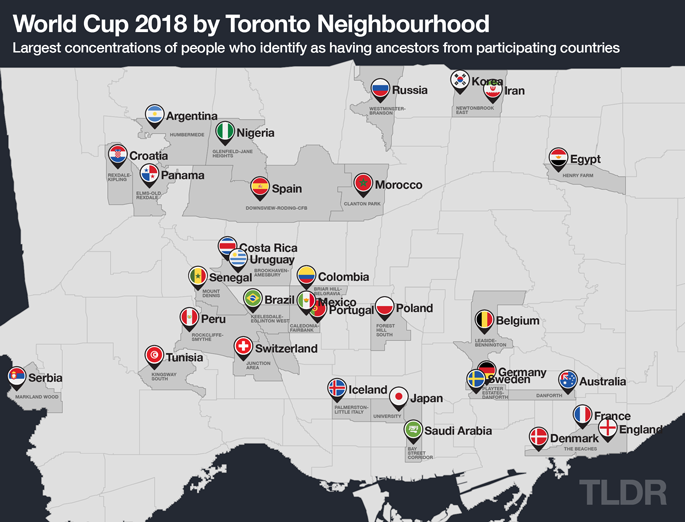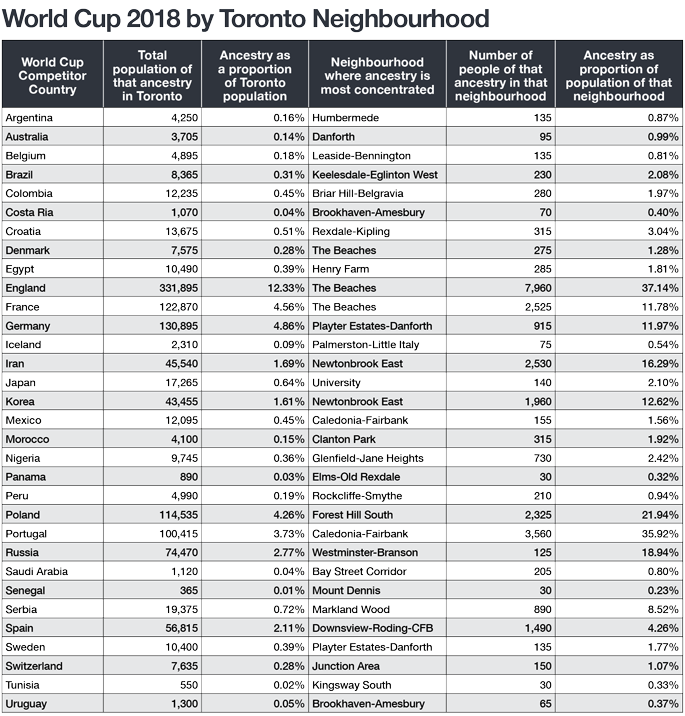June 13, 2018
As you are probably already aware, the FIFA World Cup – the most viewed sporting event on the planet – kicks off today. Here at the Mowat Centre we’re so excited for this once-every-four-years celebration of the beautiful game that we’ve decided to link it to our other favourite sport: research. It turns out that we can use census data both to show why Toronto is a fantastic place to enjoy the FIFA World Cup, and to figure out where in Toronto is best to watch each and every match in this global sporting bonanza.
World Cup Basics
The FIFA World Cup 2018 is taking place in 11 cities in Russia, this year’s host country, and runs from June 14 to July 15. The tournament will feature 32 teams from countries across 6 continents (sorry Antarctica), with reigning champions Germany looking to become the first back-to-back winners since Brazil in 1958 and 1962. They have a tough task ahead, however, as Brazil, France, Spain and others are all fielding strong teams. Notable countries that failed to qualify include four-time winner Italy and three-time runner-up Netherlands, while Iceland and Panama have qualified for the first time in the tournament’s history.
With 5 teams from Asia, 5 from Africa, 5 from South America, 3 from North and Central America, and 14 from Europe, the diverse army of fans is guaranteed to be a spectacle in and of itself, adding colourful sights and sounds to cities all over Russia for the next month. For example, who could forget the Irish supporters that fanned out across France at the European Championship in 2016, cheering on their team while grabbing international headlines for singing lullabies to babies on trams, fixing cars on the streets, and carrying a local cyclist over a crowd that was blocking his way.
Clearly, much of the magic of the World Cup actually takes place off the pitch in the uplifting cornucopia of diversity that’s created in the host country during the month-long tournament. Indeed, this global coming-together is always one of the best parts of the event, and it’s an experience that we will be watching with special interest this time round now that we know that the party will be coming to Canada, and likely to Toronto, in 2026.
Cheering in Toronto
The World Cup is a global tournament; Toronto is a global city. About half of the city’s population was born outside of Canada and, amazingly, more than 3 in 4 Torontonians are either immigrants or children of immigrants. It is no surprise, then, that every participating country in the World Cup is represented somewhere in Toronto. At one end of the scale, there are more than 330,000 Torontonians with ancestors from England; at the other end, the 365 Torontonians who trace their ancestry to Senegal will no doubt be cheering just as passionately.
People with different ancestries, however, are neither evenly distributed across the city, nor clustered in only a few spots. This can make it difficult to know where to go to find the supporters of each of the 32 countries in order to join them on game day. Since we at Mowat have a longstanding commitment to using data to improve the making of critical decisions, we have decided to help by assessing which Toronto neighbourhoods have the largest concentration of people tracing their roots back to each of the countries competing in this year’s tournament.
Here are the results of our analysis:
Source: Statistics Canada Census of Population, 2016. Additional analysis provided by City of Toronto, Social Policy, Analysis & Research section. For further inquires regarding this data set, please contact: spar@toronto.ca.
Interestingly, in addition to providing this useful guide, this exercise also teaches us a lot about the character of Toronto’s diversity. Consider, for instance, that 59 of Toronto’s 140 neighbourhoods include residents who identify as having Panamanian ancestry. But while the neighbourhood of Elms-Old Rexdale has the highest concentration of Panamanian residents, that concentration adds up to 30 people.
It is no surprise, then, that every participating country in the World Cup is represented somewhere in Toronto.
Similar patterns hold for most countries and neighbourhoods.
- 26 of the 32 participating countries have representation in at least half (70) of Toronto’s 140 neighbourhoods and even the least widespread ancestry (Serbian) is represented in 25 neighbourhoods.
- No neighbourhood has all 32 participating countries represented among its residents (though 4 neighbourhoods do have representation from 31 countries), while no neighbourhood has fewer than 16 participating countries represented.
- Only 8 of the 32 participating countries have descendants who form more than 10 per cent of a Toronto neighbourhood’s population (England, France, Germany, Iran, Korea, Poland, Portugal, and Russia).
- Seventeen of the 32 participating countries made it on to our map on the basis of a neighbourhood concentration of fewer than 250 people.
Source: Statistics Canada Census of Population, 2016. Additional analysis provided by City of Toronto, Social Policy, Analysis & Research section. For further inquires regarding this data set, please contact: spar@toronto.ca.
In the end, the data tells us a couple of important things. First, Toronto is diverse in more than one sense. Not only does it include people who trace their ancestry to countries all over the world, but these people are typically spread out across the city. The fact that we can identify specific neighbourhoods with the highest concentration of people of a given background does not mean that diversity does not permeate each and every corner of the city.
The second thing the data tells us is that it is going to be a fun-filled month, with at least some people in the city having something to celebrate at the end of each match. So now that you know where to go to watch each and every match surrounded by the most passionate fans (and where to go to party afterwards) we hope you enjoy yourself.
Authors
Rebecca Hellam
Andrew Parkin
Reuven Shlozberg
Andrew Thies
Michael Crawford Urban
Release Date
June 14, 2018









